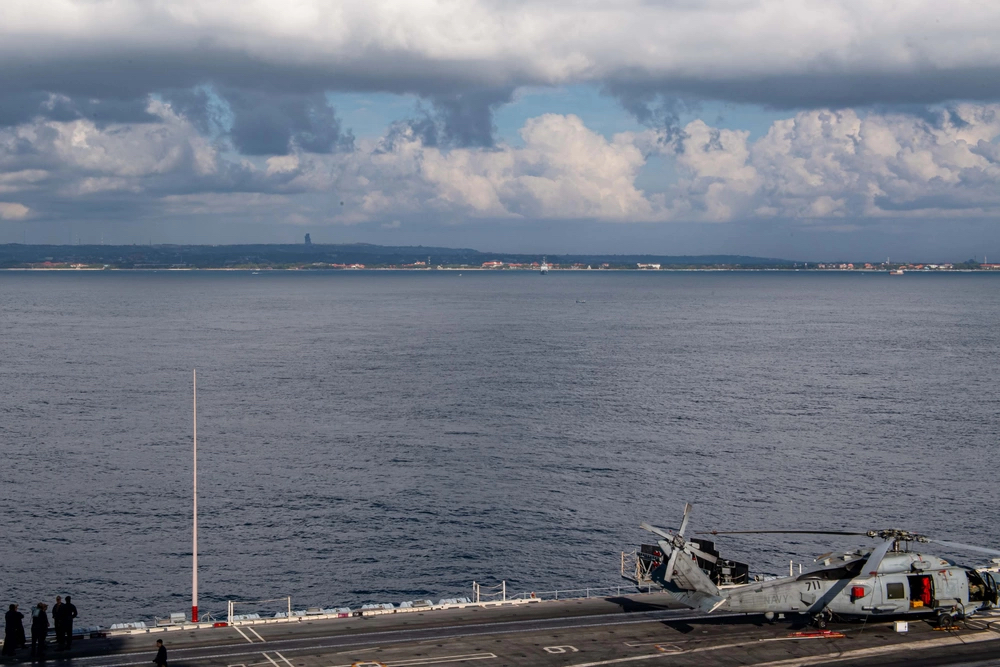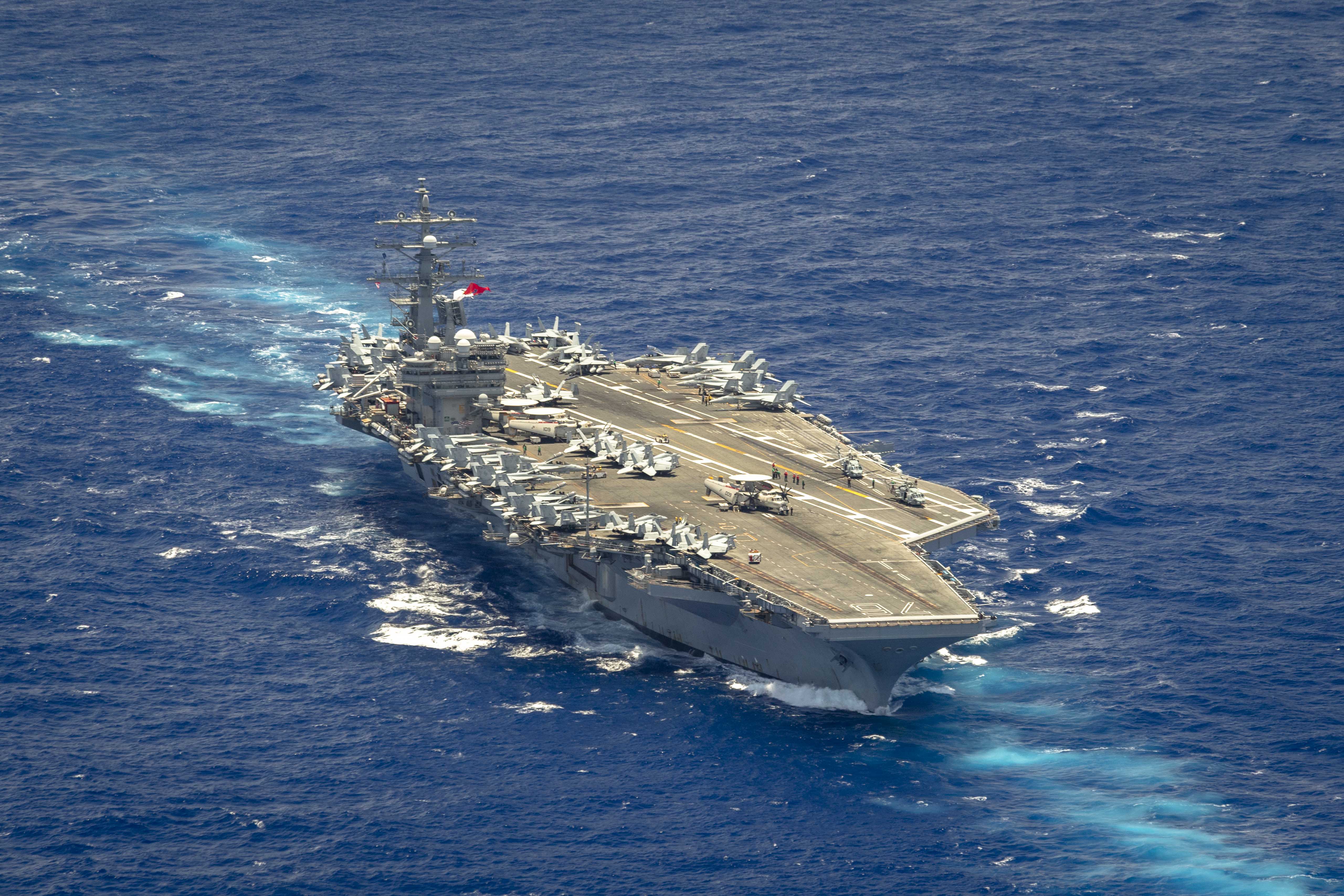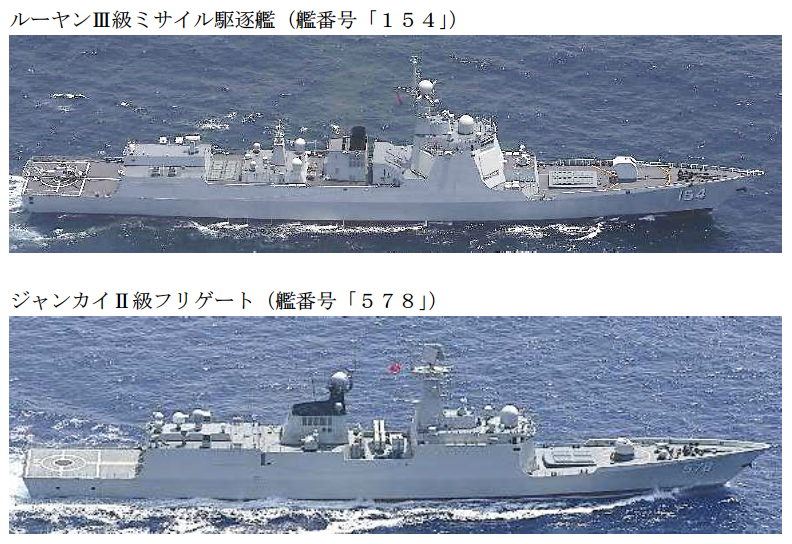
The Ronald Reagan Carrier Strike Group (CSG) made a port call to Bali, Indonesia, Sunday for a port visit following routine operations in the Indian Ocean.
Carrier USS Ronald Reagan (CVN-76), together with cruisers USS Antietam (CG-54) and USS Robert Smalls (CG-62), arrived at Tanjung Benoa Dock Sunday with the CSG escorted in from the Sea of Bali to the dock by Indonesian Navy corvettes KRI Sultan Hasanuddin (366) and KRI Sultan Iskandar Muda (367), according to a Monday news release by the Indonesian Armed Forces. The Pentagon released photos Sunday of Reagan’s arrival before pulling them down.
Earlier, on Friday, in the Indian Ocean, Reagan hosted a visit by Indonesian Navy Chief Adm. Muhammad Ali and Indonesian Armed Forces Chief of General Staff Lt. Gen. Bambang Ismawan, who flew out to the carrier.
On Sunday, as part of a response to North Korea’s Wednesday Intercontinental Ballistic Missile (ICBM) launch, the U.S Navy, Japan Maritime Self Defense Force (JMSDF) and the Republic of Korea Navy (ROKN) conducted trilateral BMD drills in the Sea of Japan with Aegis-equipped destroyers USS John Finn (DDG-113), JS Maya (DDG-179) and ROKS Yulgok Yi I (DDG-992).
“Repeated ballistic missile launches including ICBM by North Korea seriously threaten peace and security of Japan, East Asia, and the international community, which is unacceptable. This type of exercise is aimed at promoting trilateral cooperation in order to respond to the regional security challenges amid an increasingly severe security environment surrounding Japan and demonstrating the trilateral strong commitment to protecting common security and prosperity as well as to enhancing rules-based international order,” reads a release by the JMSDF on Monday.

“The exercise was conducted to practice connecting networks among each Aegis ships and sharing information on ballistic missiles. Through the exercise, we improved our tactical capabilities and joint response capabilities for ballistic missile defense,” said Captain Michiaki Mori, the commanding officer of Maya, in the release.
The ROK Ministry of National Defense release on the exercise said that bilateral U.S. – ROK and trilateral ROK-U.S.-Japan exercises were held one after another to demonstrate strong deterrence against North Korea in the air and at sea.
“This is to show the willingness to respond to North Korea’s recent ICBM launch provocation” according to the release.
“This exercise served as an opportunity to enhance our military’s ability to respond to ballistic missiles and enhance security cooperation among South Korea, the US, and Japan. Based on this, we will effectively respond to North Korea’s nuclear and missile threats,” Capt. Ki-Young Kim, commanding officer of Yulgok Yi I said in the release.
Earlier on Thursday, the U.S. held bilateral bomber air deterrence exercises involving a single U.S. Air Force B-52 Bomber with Japan and the ROK fighter aircraft as part of the usual pattern of response to North Korean missile launches.
In the ROK, the B-52 conducted a deterrence flight over the Korean peninsula with two Republic of Korea Air Force (ROKAF) F-15K fighters and four USAF F-16 fighters based in the ROK. While over Japan, the B-52 conducted a deterrence flight west of the main island of Kyushu with four Japan Air Self Defense Force (JASDF) F-2 fighters and a USAF KC-135 tanker.
China Drills With Russia

A PLAN Surface Action Group left the port of Qingdao Saturday to take part in the maritime portion of the Chinese-Russian joint drills “ Northern Interaction 2023,” reported the PLA Daily.
The SAG comprises of destroyers CNS Guiyang (119) and CNS Qiqihar (121), frigates CNS Zaozhuang (542) and CNS Rizhao (598) and fleet oiler CNS Taihu (889).
The People’s Liberation Army Air Force (PLAAF) will also conduct drills with their Russian counterparts as part of Northern Interaction, according to the PLA Daily.
China’s Ministry of National Defense said in a short statement on the exercise that it was according to the annual cooperation plan between the Chinese and Russian militaries. The Russian military will send naval and air units for the exercise organized by the Northern Theater of the PLA in the middle of the Sea of Japan.
“The topic of this exercise is ‘Maintaining the Security of Strategic Maritime Channels,’ which aims to enhance the level of strategic coordination between the Chinese and Russian militaries, enhance the ability to jointly maintain regional peace and stability, and respond to various security challenges,” according to the statement.
Russia has not indicated which ships and air units it will despatch. Russian Navy corvettes RFS Sovershenniy (333) and RFS Gromkiy (335) earlier conducted a port visit from June 5-11 to Shanghai and conducted a joint maritime exercise with PLAN destroyer CNS Taiyuan (131) in the waters near the Yangtze River estuary following their departure from Shanghai. Both ships arrived home to Vladivostok on Saturday.
Meanwhile, Littoral Combat Ship USS Jackson (LCS-6) arrived in Australia Monday as part of the upcoming U.S. Navy-led Pacific Partnership 2023 exercise, according to a Facebook post from the ship’s official account. Jackson’s presence in the region makes it the first time the U.S. Navy deployed four LCSs in the Indo-Pacific. USS Manchester (LCS-14), USS Oakland (LCS-24) and USS Mobile (LCS-26) are already in the region.





